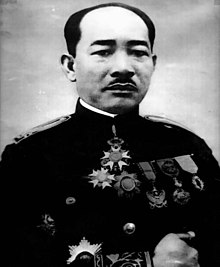Phetsarath Ratanavongsa
Phetsarath Ratanavongsa | |
|---|---|
 | |
| Head of State of Laos | |
| In office 12 October 1945 – 24 April 1946 | |
| Preceded by | Sisavang Vong |
| Succeeded by | Sisavang Vong |
| Prime Minister of Luang Phrabang | |
| In office 21 August 1941 – 10 October 1945 | |
| Monarch | Sisavang Vong |
| Preceded by | Office created |
| Succeeded by | Phaya Khammao |
| Personal details | |
| Born | 19 January 1890 Luang Prabang Kingdom of Luang Phrabang |
| Died | 14 October 1959 (aged 69) Luang Prabang Kingdom of Laos |
| Political party | Lao Issara (1945-1949) |
| Spouse(s) | Nhin Kham Venne Apinnaphon Yongchaiyudh |
| Parents |
|
Prince Phetsarath Ratanavongsa (Somdej Chao Maha Uparaja Petsaraj Ratanavongsa (Lao: ສົມເດັຈເຈົ້າ ມຫາ ອຸປຣາຊ ເພັຊຣາຊ ຣັຕນວົງສາ) (19 January 1890 – 14 October 1959) was the 1st Prime Minister of Luang Phrabang in French Laos from 21 August 1941 to 10 October 1945,[1] and Head of State of Laos between 12 October 1945 and 4 April 1946.
Biography
Early life
Phetsarath was born on 19 January 1890 in the
Government service: 1914–1941
In 1914, he became a clerk at the Office of the French governor in Vientiane. Two years later he was promoted to assistant secretary to the French governor. In 1919 he received the title of Somdeth Chao Ratsaphakhinay, a title held by his father and one of the highest ranks in the country. That same year he was named Director of Indigenous Affairs of Laos operating under the French governor in Laos.
As the country's last uparaja, he became a leading figure of modern Laos. He established the system of ranks and titles of the civil service, promotion and pension plans, and created a Lao consultative assembly, reorganized the king's Advisory Council. Phetsarath reorganized the administrative system of the Buddhist clergy, and established a system of schools for educating monks in Pali. He created the Institute of Law and Administration to train entry level officers (Samien) who would then move up the ladder as Phouxouei, Chao Meuang, and Chao Khoueng successively. He set up rules to reward, reassign, and promote deserving civil servants, and created the judicial system, including civil and penal codes.
Japanese occupation and Lao Issara: 1941–1957

Phetsarath played a dominant role in Lao politics before and after the Japanese occupation. He was the Prime Minister of Luang Phrabang, beginning in August 1941,[1] ascending in prominence under the promises for power from Japan. From 1941 to 1945, Phetsarath attempted to supplant officials in Laos and Vietnam, but in the regions of Vietnam, the resistance from the local proletariat was too strong.[2]
In March 1945 Japan overthrew the French rule in all of Indochina, including Laos. On 8 April 1945 King Sisavang Vong had declared–under Japanese pressure and at the urging of Phetsarath–that his kingdom was no longer a French protectorate. Shortly thereafter however, on 28 August 1945, Japan surrendered.
In the ensuing power vacuum, Phetsarath moved to unite the southern provinces of Laos with Luang Phrabang. This put him at odds with the pro-French King Sisavang Vong, who had agreed with the French that he intended to have the country resume its former status as a French colony. Phetsarath sent a telegram to all Laotian provincial governors notifying them that the Japanese surrender did not affect Laos' status as independent and warning them to resist any foreign intervention. On 15 September Phetsarath declared a unified Kingdom of Laos which led the King to dismiss him from his post as Prime Minister on 10 October.
Phetsarath and other Lao nationalists then created the Lao Issara (Free Laos) movement and took control of the country. The Lao Issara provisional assembly under Phetsarath proclaimed the deposition of the King and appointed Phetsarath as "Head of State". As the French retook control of Laos, Phetsarath fled in April 1946 to Thailand, where he led the Lao Issara government-in-exile. The group was dissolved in 1949 and its former members were allowed to return to Laos under amnesty.
Return: 1957–1959
In March 1957, he returned to Vientiane where he received a wild welcome. On 10 April 1957, he traveled to
He was offered an official government residence in Vientiane, but preferred to stay in his villa,
In part because of his popularity and in part because of his perceived shakti/shiva power, many Lao people hang his picture in their homes.
Awards and decorations
 Legion of Honour
Legion of Honour Chevalier of the Ordre des Palmes académiques (France)
Chevalier of the Ordre des Palmes académiques (France)- Kingdom of Cambodia)[3]
- Royal Order of Sowathara (Cambodia)[4]
- Other decorations
References
- Sila Viravong: Chao Phetcharat - Strong Man of Kingdom of Laos, Thai Translation by Sommai Premjit, Matichon Press, BE 2542 (AD 1999), ISBN 974-321-465-8
- Søren Ivarsson and Christopher E. Goscha: Prince Phetsarath (1890–1959): Nationalism and Royalty in the Making of Modern Laos, Journal of Southeast Asian Studies (2007), 38: 55–81, Cambridge University Press
- ^ a b Evans, Grant (2002). A Short history of Laos, the land in between (PDF). Allen & Unwin.
- ^ Author = Long Nguyen Chum Plains - epic Hmong Chapter 6 France again. Platform independent short. Archived 2012-06-13 at the Wayback Machine
- ^ "Indochina Medals - Cambodia - CM05 Sena Jayaseddh Medal". www.indochinamedals.com. Retrieved 2021-11-18.
- ^ "Indochina Medals - Cambodia - CM15 Royal Order of Sowathara". www.indochinamedals.com. Retrieved 2021-11-18.
